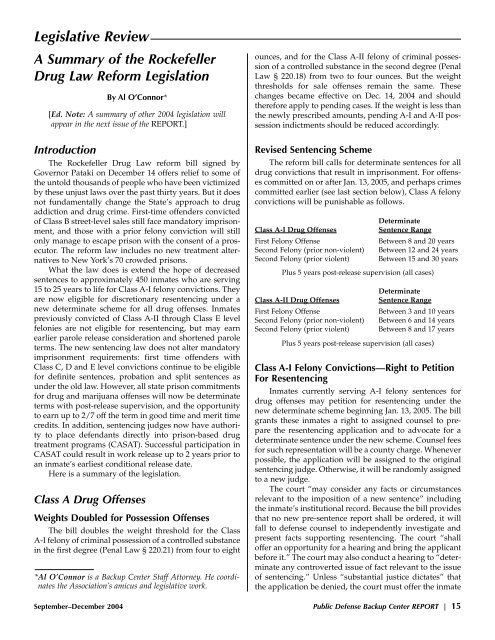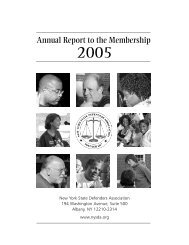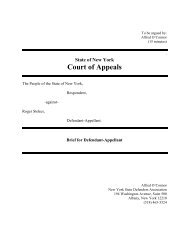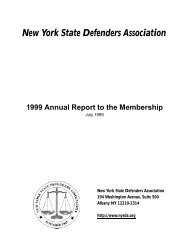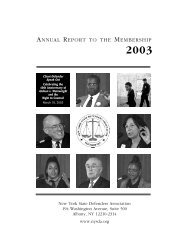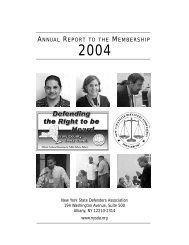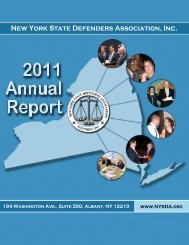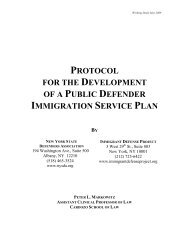Summary of the Rockefeller Drug Law Reform Legislation
Summary of the Rockefeller Drug Law Reform Legislation
Summary of the Rockefeller Drug Law Reform Legislation
You also want an ePaper? Increase the reach of your titles
YUMPU automatically turns print PDFs into web optimized ePapers that Google loves.
Legislative Review<br />
A <strong>Summary</strong> <strong>of</strong> <strong>the</strong> <strong>Rockefeller</strong><br />
<strong>Drug</strong> <strong>Law</strong> <strong>Reform</strong> <strong>Legislation</strong><br />
By Al O’Connor*<br />
[Ed. Note: A summary <strong>of</strong> o<strong>the</strong>r 2004 legislation will<br />
appear in <strong>the</strong> next issue <strong>of</strong> <strong>the</strong> REPORT.]<br />
Introduction<br />
The <strong>Rockefeller</strong> <strong>Drug</strong> <strong>Law</strong> reform bill signed by<br />
Governor Pataki on December 14 <strong>of</strong>fers relief to some <strong>of</strong><br />
<strong>the</strong> untold thousands <strong>of</strong> people who have been victimized<br />
by <strong>the</strong>se unjust laws over <strong>the</strong> past thirty years. But it does<br />
not fundamentally change <strong>the</strong> State’s approach to drug<br />
addiction and drug crime. First-time <strong>of</strong>fenders convicted<br />
<strong>of</strong> Class B street-level sales still face mandatory imprisonment,<br />
and those with a prior felony conviction will still<br />
only manage to escape prison with <strong>the</strong> consent <strong>of</strong> a prosecutor.<br />
The reform law includes no new treatment alternatives<br />
to New York’s 70 crowded prisons.<br />
What <strong>the</strong> law does is extend <strong>the</strong> hope <strong>of</strong> decreased<br />
sentences to approximately 450 inmates who are serving<br />
15 to 25 years to life for Class A-I felony convictions. They<br />
are now eligible for discretionary resentencing under a<br />
new determinate scheme for all drug <strong>of</strong>fenses. Inmates<br />
previously convicted <strong>of</strong> Class A-II through Class E level<br />
felonies are not eligible for resentencing, but may earn<br />
earlier parole release consideration and shortened parole<br />
terms. The new sentencing law does not alter mandatory<br />
imprisonment requirements: first time <strong>of</strong>fenders with<br />
Class C, D and E level convictions continue to be eligible<br />
for definite sentences, probation and split sentences as<br />
under <strong>the</strong> old law. However, all state prison commitments<br />
for drug and marijuana <strong>of</strong>fenses will now be determinate<br />
terms with post-release supervision, and <strong>the</strong> opportunity<br />
to earn up to 2/7 <strong>of</strong>f <strong>the</strong> term in good time and merit time<br />
credits. In addition, sentencing judges now have authority<br />
to place defendants directly into prison-based drug<br />
treatment programs (CASAT). Successful participation in<br />
CASAT could result in work release up to 2 years prior to<br />
an inmate’s earliest conditional release date.<br />
Here is a summary <strong>of</strong> <strong>the</strong> legislation.<br />
Class A <strong>Drug</strong> Offenses<br />
Weights Doubled for Possession Offenses<br />
The bill doubles <strong>the</strong> weight threshold for <strong>the</strong> Class<br />
A-I felony <strong>of</strong> criminal possession <strong>of</strong> a controlled substance<br />
in <strong>the</strong> first degree (Penal <strong>Law</strong> § 220.21) from four to eight<br />
*Al O’Connor is a Backup Center Staff Attorney. He coordinates<br />
<strong>the</strong> Association’s amicus and legislative work.<br />
ounces, and for <strong>the</strong> Class A-II felony <strong>of</strong> criminal possession<br />
<strong>of</strong> a controlled substance in <strong>the</strong> second degree (Penal<br />
<strong>Law</strong> § 220.18) from two to four ounces. But <strong>the</strong> weight<br />
thresholds for sale <strong>of</strong>fenses remain <strong>the</strong> same. These<br />
changes became effective on Dec. 14, 2004 and should<br />
<strong>the</strong>refore apply to pending cases. If <strong>the</strong> weight is less than<br />
<strong>the</strong> newly prescribed amounts, pending A-I and A-II possession<br />
indictments should be reduced accordingly.<br />
Revised Sentencing Scheme<br />
The reform bill calls for determinate sentences for all<br />
drug convictions that result in imprisonment. For <strong>of</strong>fenses<br />
committed on or after Jan. 13, 2005, and perhaps crimes<br />
committed earlier (see last section below), Class A felony<br />
convictions will be punishable as follows.<br />
Class A-I <strong>Drug</strong> Offenses<br />
First Felony Offense<br />
Second Felony (prior non-violent)<br />
Second Felony (prior violent)<br />
Determinate<br />
Sentence Range<br />
Between 8 and 20 years<br />
Between 12 and 24 years<br />
Between 15 and 30 years<br />
Plus 5 years post-release supervision (all cases)<br />
Determinate<br />
Class A-II <strong>Drug</strong> Offenses<br />
Sentence Range<br />
First Felony Offense<br />
Between 3 and 10 years<br />
Second Felony (prior non-violent) Between 6 and 14 years<br />
Second Felony (prior violent) Between 8 and 17 years<br />
Plus 5 years post-release supervision (all cases)<br />
Class A-I Felony Convictions—Right to Petition<br />
For Resentencing<br />
Inmates currently serving A-I felony sentences for<br />
drug <strong>of</strong>fenses may petition for resentencing under <strong>the</strong><br />
new determinate scheme beginning Jan. 13, 2005. The bill<br />
grants <strong>the</strong>se inmates a right to assigned counsel to prepare<br />
<strong>the</strong> resentencing application and to advocate for a<br />
determinate sentence under <strong>the</strong> new scheme. Counsel fees<br />
for such representation will be a county charge. Whenever<br />
possible, <strong>the</strong> application will be assigned to <strong>the</strong> original<br />
sentencing judge. O<strong>the</strong>rwise, it will be randomly assigned<br />
to a new judge.<br />
The court “may consider any facts or circumstances<br />
relevant to <strong>the</strong> imposition <strong>of</strong> a new sentence” including<br />
<strong>the</strong> inmate’s institutional record. Because <strong>the</strong> bill provides<br />
that no new pre-sentence report shall be ordered, it will<br />
fall to defense counsel to independently investigate and<br />
present facts supporting resentencing. The court “shall<br />
<strong>of</strong>fer an opportunity for a hearing and bring <strong>the</strong> applicant<br />
before it.” The court may also conduct a hearing to “determinate<br />
any controverted issue <strong>of</strong> fact relevant to <strong>the</strong> issue<br />
<strong>of</strong> sentencing.” Unless “substantial justice dictates” that<br />
<strong>the</strong> application be denied, <strong>the</strong> court must <strong>of</strong>fer <strong>the</strong> inmate<br />
September–December 2004 Public Defense Backup Center REPORT | 15
Legislative Review continued<br />
a determinate sentence as an alternative to <strong>the</strong> 15 to 25<br />
year to life sentence he or she is now serving. The inmate<br />
has <strong>the</strong> option to accept or reject <strong>the</strong> new determinate sentence.<br />
But in ei<strong>the</strong>r case, he or she has <strong>the</strong> right to appeal<br />
from a determinate sentence so <strong>of</strong>fered or imposed on <strong>the</strong><br />
ground that it is harsh and excessive.<br />
There are reportedly 446 inmates who are eligible for<br />
resentencing under this reform. As <strong>of</strong> Sept. 30, 2004, <strong>the</strong>y<br />
were serving sentences from <strong>the</strong> city <strong>of</strong> New York and 27<br />
counties (Albany, Broome, Cayuga, Chemung, Columbia,<br />
Dutchess, Erie, Fulton, Jefferson, Monroe, Nassau,<br />
Oneida, Onondaga, Ontario, Orange, Putnam, Rockland,<br />
Schenectady, Seneca, Steuben, Suffolk, Sullivan, Tioga,<br />
Tompkins, Ulster, Wayne, Westchester).<br />
Revised Sentencing Scheme—Class B<br />
through E Level <strong>Drug</strong> and Marijuana<br />
Offenses<br />
Lower level felony drug and marijuana <strong>of</strong>fenses will<br />
also be punishable by determinate sentence when <strong>the</strong><br />
court commits <strong>the</strong> defendant to state prison. For <strong>of</strong>fenses<br />
committed on or after Jan. 13, 2005, and perhaps earlier<br />
(see last section below), <strong>the</strong> new scheme will be as follows.<br />
Determinate<br />
Sentence Range<br />
First Felony Offender<br />
(years)<br />
Class B Between 1 and 9<br />
Class B (sale in or near school grounds) Between 2 and 9<br />
Class C (imprisonment not mandatory) Between 1 and 5½<br />
Class D (imprisonment not mandatory) Between 1 and 2½<br />
Class E (imprisonment not mandatory) Between 1 and 1½<br />
Plus post-release supervision<br />
Class B or C—Between 1 and 2 years<br />
Class D or E—1 year<br />
Second Felony Offender Determinate<br />
(prior non-violent)<br />
Sentence Range<br />
Class B<br />
Between 3½ and 12 years<br />
Class C<br />
Between 2 and 8 years<br />
Class D<br />
Between 1½ and 4 years<br />
Class E<br />
Between 1½ and 2 years<br />
Plus post-release supervision<br />
Class B or C—Between 1½ and 3 years<br />
Class D or E—Between 1 and 2 years<br />
Second Felony Offender Determinate<br />
(prior violent)<br />
Sentence Range<br />
Class B<br />
Between 6 and15 years<br />
Class C<br />
Between 3½ and 9 years<br />
Class D<br />
Between 2½ and 4½ years<br />
Class E<br />
Between 2 and 2½ years<br />
Plus post-release supervision<br />
Class B or C—Between 1½ and 3 years<br />
Class D or E—Between 1 and 2 years<br />
Good Time and Merit Time Reductions<br />
Determinate Sentences—All drug <strong>of</strong>fenders serving<br />
determinate sentences will be eligible for a standard 1/7th<br />
reduction <strong>of</strong> <strong>the</strong> term as good time. They will also be eligible<br />
for an additional 1/7th reduction as merit time. To<br />
earn merit time, drug <strong>of</strong>fenders will be required to participate<br />
in assigned work and treatment programs, and<br />
obtain a.) a GED, or b.) an alcohol and substance abuse<br />
certificate, or c.) a vocational trade certificate, or d.) perform<br />
400 hours in a community work crew.<br />
Indeterminate Sentences—Class A-I drug <strong>of</strong>fenders<br />
serving indeterminate sentences may continue to earn up<br />
to 1/3 <strong>of</strong>f <strong>the</strong>ir minimum terms as merit time, and Class<br />
A-II through E drug <strong>of</strong>fenders may continue to earn up to<br />
1/6th <strong>of</strong>f <strong>the</strong>ir minimum terms. The bill includes a bonus<br />
1/6th merit time allowance for Class A-II through E<br />
felony <strong>of</strong>fenders who committed <strong>the</strong> <strong>of</strong>fense prior to Jan.<br />
13, 2005, and received an indeterminate term. By participating<br />
in two or more <strong>of</strong> <strong>the</strong> above-listed programs, <strong>the</strong>y<br />
will be eligible for an additional 1/6th merit time<br />
allowance, or a total <strong>of</strong> 1/3 <strong>of</strong>f <strong>the</strong>ir minimum terms.<br />
Early Termination <strong>of</strong> Parole—<br />
Indeterminate Sentences<br />
The bill provides for mandatory early termination <strong>of</strong><br />
parole after three years <strong>of</strong> unrevoked supervision for persons<br />
serving indeterminate sentences for Class A-I and A-<br />
II felony drug <strong>of</strong>fenses, and after two years for all o<strong>the</strong>r<br />
drug <strong>of</strong>fenses. This section <strong>of</strong> <strong>the</strong> bill becomes effective on<br />
Feb. 12, 2005.<br />
Expanded CASAT and Judicial<br />
Placements<br />
Under current law, certain non-violent inmates are eligible<br />
for <strong>the</strong> Comprehensive Alcohol and Substance<br />
Abuse Treatment program (CASAT) when <strong>the</strong>y are within<br />
two years <strong>of</strong> initial parole eligibility or conditional release<br />
(indeterminate and determinate sentences). After six<br />
months <strong>of</strong> prison-based treatment, <strong>the</strong>y are eligible for<br />
work release and community-based treatment for an<br />
additional 18 months. The Department <strong>of</strong> Correctional<br />
Services (DOCS) selects inmates for participation in <strong>the</strong><br />
CASAT program.<br />
For drug <strong>of</strong>fenses, <strong>the</strong> reform bill advances <strong>the</strong> eligibility<br />
date to inmates within 2 years and 6 months <strong>of</strong> <strong>the</strong>ir<br />
anticipated parole or conditional release date (giving<br />
advance credit for available good time and merit time<br />
credits). Second felony Class B drug <strong>of</strong>fenders serving<br />
determinate sentences, however, must serve a minimum<br />
<strong>of</strong> 18 months (jail time and prison time) before transfer to<br />
a residential treatment program. The bill also authorizes<br />
16 | Public Defense Backup Center REPORT Volume XIX Number 4
judges to select defendants at <strong>the</strong> time <strong>of</strong> sentence for<br />
future participation in <strong>the</strong> CASAT program, a change that<br />
become effective on Dec. 14, 2004.<br />
SHOCK and Willard <strong>Drug</strong> Treatment<br />
Program<br />
No real substantive changes were made to <strong>the</strong> eligibility<br />
criteria for SHOCK. The statute (Correction <strong>Law</strong> §<br />
865) has been amended to accommodate <strong>the</strong> new determinate<br />
sentencing scheme. <strong>Drug</strong> <strong>of</strong>fenders with determinate<br />
sentences, who are under 40 and have never been<br />
previously committed to DOCS, and who will become eligible<br />
for conditional release within 3 years may participate<br />
in SHOCK. However, second felony Class B drug<br />
<strong>of</strong>fenders are ineligible for <strong>the</strong> program, even if <strong>the</strong>y are<br />
within <strong>the</strong> three-year time frame at <strong>the</strong> time <strong>of</strong> DOCS<br />
reception. (The new minimum determinate sentence in<br />
this category is 3½ years.)<br />
Under <strong>the</strong> new determinate sentencing scheme, <strong>the</strong><br />
Willard program will continue to be available to clients<br />
convicted <strong>of</strong> Class E felony drug <strong>of</strong>fenses and, with <strong>the</strong><br />
consent <strong>of</strong> <strong>the</strong> district attorney, Class D felony drug<br />
<strong>of</strong>fenses. The law has been clarified to eliminate <strong>the</strong> confusing<br />
restriction on Willard eligibility for defendants<br />
who are “subject to an undischarged term <strong>of</strong> imprisonment.”<br />
This language was never intended to mean defendants<br />
who were on parole at <strong>the</strong> time <strong>of</strong> <strong>the</strong> instant<br />
<strong>of</strong>fense. The amended statute makes clear that only those<br />
defendants who are in state prison or “awaiting delivery”<br />
to DOCS for ano<strong>the</strong>r <strong>of</strong>fense are ineligible for Willard<br />
placement.<br />
These changes become effective Jan. 13, 2005 and<br />
apply to <strong>of</strong>fenses committed on or after that date.<br />
Lifetime Probation Sentences for<br />
Material Assistance<br />
The period <strong>of</strong> probation supervision for Class B first<br />
felony <strong>of</strong>fenders who <strong>of</strong>fer material assistance in <strong>the</strong> prosecution<br />
<strong>of</strong> drug <strong>of</strong>fenses has been reduced to 25 years<br />
(from life). For Class A-II and second felony Class B<br />
<strong>of</strong>fenders <strong>the</strong> probation term remains life. This change<br />
goes into effect on Jan. 13, 2005.<br />
Plea Restrictions<br />
CPL § 220.10 (5) (a)(ii) has been amended to authorize<br />
a plea to a Class B drug <strong>of</strong>fense from an indictment charging<br />
a Class A-I drug <strong>of</strong>fense. This provision became effective<br />
on Dec. 27, 2004. (The bill has an apparent drafting<br />
error and actually says <strong>the</strong> thirteenth, not <strong>the</strong> thirtieth day<br />
after <strong>the</strong> Governor’s signature.)<br />
Effective Date <strong>of</strong> New Sentencing<br />
Scheme<br />
The language and structure <strong>of</strong> <strong>the</strong> reform bill suggests<br />
that determinate sentences will be available only for<br />
<strong>of</strong>fenses committed on or after <strong>the</strong> effective date <strong>of</strong> <strong>the</strong><br />
new sentencing provisions, 30 days after <strong>the</strong> Governor’s<br />
signature, or Jan. 13, 2005. These changes are included in<br />
sections 35 and 36 <strong>of</strong> <strong>the</strong> bill, which become effective “on<br />
<strong>the</strong> thirtieth day after it shall have become a law . . . and<br />
shall apply to crimes committed on or after <strong>the</strong> effective<br />
date <strong>the</strong>re<strong>of</strong>.” Moreover, <strong>the</strong> bill includes provisions<br />
specifically designed to benefit defendants whose crimes<br />
were committed prior to that date and who receive indeterminate<br />
terms. For example, Class A-I <strong>of</strong>fenders will<br />
automatically be eligible for resentencing on Jan. 13, 2005.<br />
All o<strong>the</strong>r drug <strong>of</strong>fenders will be eligible to earn merit time<br />
equal to 1/3 <strong>of</strong> <strong>the</strong>ir minimum indeterminate terms, as<br />
well as early termination <strong>of</strong> parole after two or three years<br />
<strong>of</strong> unrevoked supervision.<br />
On <strong>the</strong> o<strong>the</strong>r hand, to <strong>the</strong> extent that a current client<br />
may substantially benefit from <strong>the</strong> new determinate sentencing<br />
options, you may wish to cite People v Behlog, 74<br />
NY2d 237 (1989), as authority for applying <strong>the</strong> new<br />
scheme to <strong>of</strong>fenses committed prior to Jan. 13, 2005. In<br />
Behlog, <strong>the</strong> Court <strong>of</strong> Appeals held that 1985 amendments<br />
increasing <strong>the</strong> dollar amounts <strong>of</strong> <strong>the</strong> larceny statutes were<br />
“ameliorative” and could be applied to <strong>of</strong>fenses committed<br />
prior to <strong>the</strong> effective date <strong>of</strong> <strong>the</strong> legislation. “The<br />
rationale for this exception is that by mitigating <strong>the</strong> punishment<br />
<strong>the</strong> Legislature is necessarily presumed – absent<br />
some evidence to <strong>the</strong> contrary – to have determined that<br />
<strong>the</strong> lesser penalty sufficiently serves <strong>the</strong> legitimate<br />
demands <strong>of</strong> <strong>the</strong> criminal law. Imposing a harsher penalty<br />
in such circumstances would serve no valid penological<br />
purpose” (at 240). <br />
In 2005—Get a friend to join NYSDA<br />
September–December 2004 Public Defense Backup Center REPORT | 17
New Sentencing Chart for <strong>Drug</strong> Offenses<br />
Under <strong>Rockefeller</strong> <strong>Drug</strong> <strong>Law</strong> <strong>Reform</strong><br />
Class Felony Determinate<br />
Sentence<br />
Term<br />
Post-<br />
Release<br />
Supervision<br />
Probation<br />
Permitted<br />
Alternative<br />
Definite Sentence<br />
Permitted<br />
Y.O.<br />
Permitted<br />
Attempt Parole<br />
Supervision<br />
Sentence<br />
Permitted<br />
Shock<br />
Permitted<br />
A-I First Offense 8 - 20 5 No No No A-I No No Yes<br />
A-I Prior Non-Violent 12 - 24 5 No No No A-I No No Yes<br />
A-I Prior Violent 15 - 30 5 No No No A-I No No Yes<br />
A-II First Offense 3 - 10 5 Yes/Life 1 No No A-II No Yes 3 Yes<br />
A-II Prior Non-Violent 6 - 14 5 Yes/Life 1 No No A-II No No Yes<br />
A-II Prior Violent 8 - 17 5 Yes/Life 1 No No A-II No No Yes<br />
B First Offense 1 - 9 1 – 2 Yes/25 1 No Yes C No Yes 3 Yes<br />
B Sale Near School 2 - 9 1 – 2 Yes/25 1 No Yes C No Yes 3 Yes<br />
B Prior Non-Violent 3 ½ - 12 1 ½ - 3 Yes/Life 1 No NO C No No Yes<br />
B Prior Violent 6-15 1 ½ - 3 Yes/Life 1 No NO C No No Yes<br />
C First Offense 1 – 5 ½ 1 – 2 Yes/5 Yes 1 or less Yes D No Yes Yes<br />
C Prior Non-Violent 2 – 8 1 ½ – 3 NO NO NO D No Yes 3 Yes<br />
C Prior Violent 3 ½ - 9 1 ½ – 3 NO NO NO D No No Yes<br />
D First Offense 1 – 2 ½ 1 Yes/5 Yes 1 or less Yes E No Yes Yes<br />
D Prior Non-Violent 1 ½ - 4 1 – 2 NO NO NO E Yes 2 Yes 3 Yes<br />
D Prior Violent 2 ½ - 4 ½ 1 – 2 NO NO NO E No No Yes<br />
E First Offense 1 – 1 ½ 1 Yes/5 Yes 1 or less Yes A misd. No Yes Yes<br />
E Prior Non-Violent 1 ½ - 2 1 – 2 NO NO NO A misd. Yes Yes 3 Yes<br />
E Prior Violent 2 – 2 ½ 1 – 2 NO NO NO A misd. No No Yes<br />
CASAT<br />
Sentence<br />
Permitted<br />
_________________________<br />
1 Requires recommendation <strong>of</strong> DA and material assistance in prosecution <strong>of</strong> drug <strong>of</strong>fense.<br />
2 Requires consent <strong>of</strong> DA.<br />
3 Cannot have previously served time in state prison. Prior felony cannot have been for any <strong>of</strong>fense listed in Correction <strong>Law</strong> §865(1). Only if less than 3 years to<br />
conditional release.<br />
Center for Community Alternatives<br />
115 E. Jefferson St., Suite 300 Syracuse, NY 13202 ph 315/422-5638 fax 315/471-4924<br />
39 W. 19 th St., 10 th Fl New York, NY 10011 ph 212/691-1911 fax 212/675-0825<br />
www.communityalternatives.org<br />
18 | Public Defense Backup Center REPORT Volume XIX Number 4


